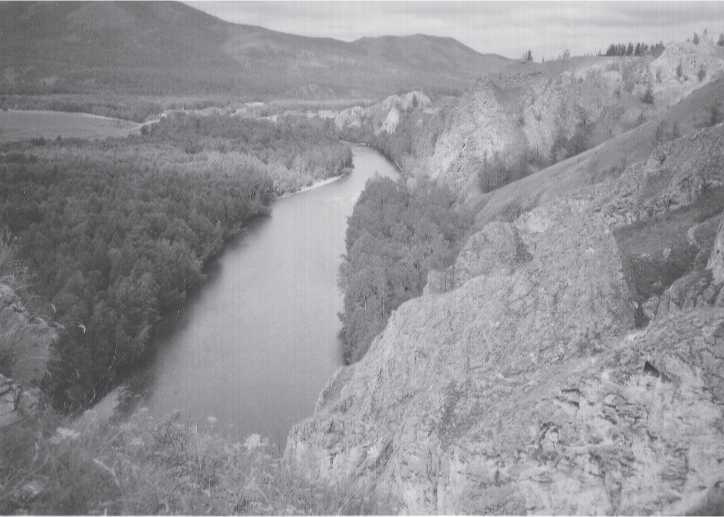Malaya Seeya (Small Seeya, named after nearby Seeya village) is a Paleolithic hillside open site located in the eastern ridges of Kuznetsk Ala-Tau, a mountainous and forested region of the middle Yenisei drainage, Khakasia. It is situated 500 m fTom the left bank of the Bely Iyus River and 35 m up-slope. Kuzmin and Orlova (1998:8) locate the site at 54° 50' N, 89°42' E. Figs. 3.67-3.70 illustrate the environment around Malaya Seeya, including caves in the vicinity that were used by hyenas. Malaya Seeya was first discovered and tested by Nicolai Ovodov in 1974 after he learned from brickmakers in the area that they had found bones and artifacts in the hillside clay deposits that they were mining for brickmaking (Fig. 3.71). About 500m2 of the site had been destroyed in the mining operation. Ovodov’s testing continued in 1975, turning up some 583 Paleolithic stone tools and manufacturing debris, plus a few bone artifacts. It was subsequently more extensively excavated by V. E. Larichev in 1978, whose two seasons of fieldwork turned up more artifacts and 4800 pieces of bone, from which Ovodov identified 13 species. Larichev’s bone samples produced carbon-14 dates of 34 500 BP and 34 420 BP (Vasili’ev et al. 2002:523). Currently, Malaya Seeya is being further excavated by Yu. P. Kholyushkin and additional carbon-14 dates considerably younger have been derived from bone and charcoal. Vasili’ev et al. (2002:523) list dates as ranging fTom 29 450 BP to 20 300 BP. This large range in age dates and the hillside slope of the cultural level have contributed to the controversy about Malaya Seeya - namely, did it have multiple occupations? A number of Quaternary geologists have visited and studied the site, including V. M. Muratov and S. M. Tseitlin, Moscow; S. L. Troitsky, Novosibirsk; and V. P. Chekha and A. F. Yamskikh, Krasnoyarsk. The authors together visited the testing in progress in July, 2000. We saw an in situ artifact that Kholyushkin had exposed at a depth of about 1 m in a 3 m deep test pit dug into light brown, sticky, loamy clay that showed no signs of horizontal stratification. Additional information about Malaya Seeya can be found in Abramova et al. (1991), Chekha and Ovodov (1992), Larichev (1978), and Lisitsyn (1997). As suggested above, the site is in need of a comprehensive geological and archaeological analysis.
The 1974-1975 fauna excavated and identified by Ovodov (Chekha and Ovodov 1992) included: marmot (Marmota baibacina), two pieces; hare (Lepus sp.), 32; brown bear (Ursus arctos), five; Asiatic wild ass, onager (Equus hemionus), three; horse (Equus

Fig. 3.67 The Malaya Seeya landscape. View of the mountainous setting of Malaya Seeya, out of sight to the left. The Seeya River rushes into the distance. View taken from the limestone cliff at the opening to Tokhasky Grotto, a hyena den 83 m vertically above the river. We include this and the three following photographs to make the point that late Pleistocene hyenas were present in the Malaya Seeya area (CGT color Tokhasky 7-22-00:19).
Caballus), 49; onager aut hors, 39; rhinoceros (Coelodonta antiquitatis), eight; mammut (Mammonteus primgenius), three; red deer (Cervus elaphus), 30; Mongolian gazelle (Procarpa gutturoza), one; wild sheep (Ovis ammon), three; goat, ibex, markhor (Capra sibirica), one; wild goat-sheep, 131; reindeer (caribou) (Rangifer tarandus), 290; reindeer, wild sheep/goat, 4054; bison (Bisonpriscus), 113. Clearly, the reindeer are the most commonly represented species. N. M. Ermolova, who studied the faunal remains excavated in 1976 by V. E. Larichev, also found reindeer to occur most frequently. In addition, she identified wolverine and fox.




 World History
World History









